|
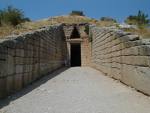 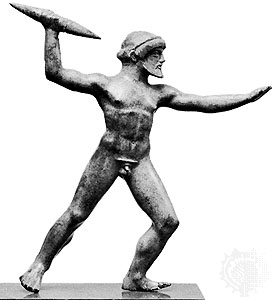 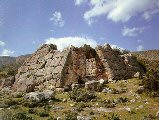  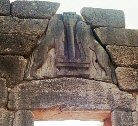
 Ancient Greece:
('Hellas')
Ancient Greece:
('Hellas')
The
Greek empire arose from a collective of feuding �tribes� which filled the vacuum of the fallen Minoan empire, (2,700 BC � 1,400 BC).
Unfortunately, there is too little contemporary text from this early
transition period to know the exact path at this early stage. We know
that before the emergence of the Greeks, the Mediterranean basin was a
melting pot of cultures and trade, with various empires such as the
Minoan, Mycenaean, Etruscan, Anatolian, Phoenician and Egyptians having already
firmly stamped their cultural mark on the region. It is
known that after the Minoans, the Mycenaean culture arose and prospered in the region, culminating in the creation of the Greek
empire.
It is recorded that several hundred years
following its creation, learned men of ancient Greece such as (Pythagoras,
Plato etc)
began to secure much of their wisdom and knowledge from exchanges with
the Egyptian and Mesopotamian priesthoods. This �Golden-age� of
philosophy, science and the arts occurred following the expansion of the
Greek empire into Egypt, around the time of Alexander the great (350
BC). Zonares
(3) wrote concerning the transfer of arithmetic and astronomy to
the Greeks:
��It
is said that these came from the Chaldees to the Egyptians, and thence
to the Greeks�.
Pythagoras, the great mathematician went to the extreme of being
circumcised in order to obtain �more information than was imparted to
any other Greek� (Plut.
De Is. S. 10),
which also supports the suggesting of an association between geometry and
rituals of worship (sacred-geometry). The ancient accounts of
Pythagoras stay in Egypt reveals an interesting
fact, namely that his skillful cross-examination of the priests exposed
not only the extent of their learning, but also that at this time; they
too were apparently already ignorant of the origin of these facts.
(3)
Greek Automata: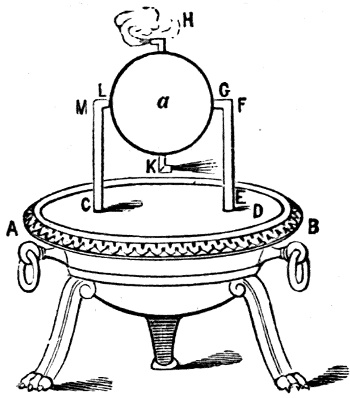
When his writings on hydraulics, pneumatics and
mechanics were translated into Latin in the sixteenth century,
Hero�s readers were amazed to discover descriptions of inventions which
included vending machines, a water-pump, a wind-organ, and the aeolipile
(the first recorded steam engine). Although today the only surviving example
of such sophisticated ancient Greek mechanics is the
Antikythera
mechanism, it is clear that complex mechanical devices existed
in ancient Greece.
(More
about Greek Automata)
|
|
Delphi:
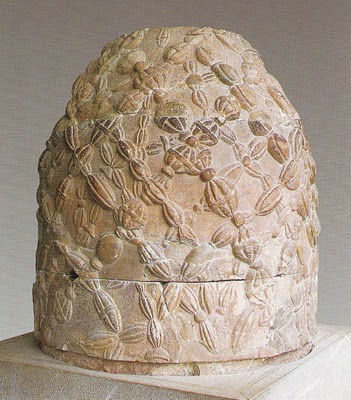
The site of the Delphine Oracle, arguably the most important oracle in
the classic world and sacred since prehistoric times
(1),
originally being a shrine to Gaia and a centre from which sacred temples
and oracle centres were placed apparently according to principles of
longitude.
Delphi is also
associated with the worship of Apollo (the sun god), who is said to have
killed the serpent Python at Delphi, essentially supplanting one
form of worship with another. The sites status as an Earth Navel was
recognised by
Herodotus, who connected the oracle centre
at Delphi with the one at Karnak in Egypt. both sites at which
Omphalos
stones have been found.
The
most famous of all the Greek oracles, Delphi contains a tradition of
geodesy in its origin myth, which says that it was located by Zeus who
released two birds from the eastern and western ends of the earth, with
the point where they flew past each other being considered the centre of
the world and therefore marked with an omphalos stone. Delphi happens to
be located 3/7th�s of the distance from the equator to the
North Pole. Delphi also lies along the same alignment formed by
connecting Dodona to Behdet in Egypt (which was the geodetic capital of
Northern Egypt before 3,000 BC according to Stecchini), and which sits
on the same longitude as Thebes and the same Latitude as Alexandria.
Herodotus connected Delphi with Thebes in his narration.
Delphi is
also associated geometrically with another two places; One in
Anatolia (Turkey) and the other in Africa, also both considered oracle centres and earth-navels. These three points form an inverted Isoscelese triangle. The top corner is based on the Oasis at Siwa, and
the third corner in Anatolia at Sardeis (Sardis). All three sites were
visited by Heraclese, who represents the collective unconsciousness
of Ancient Greece.
(More about Delphi) |
The Greek Oracle Centres:
The importance of
the oracles to the ancient Greeks is apparent from their prominence in
mythological and historical texts; however, they were never exclusive to
Greece, and although they are recorded as an Egyptian introduction, it
is known that many of the Oracle sites were shrines to the
mother-goddess or Gaia, before they were converted to the more
traditional Sybilline sanctuaries. Herodotus repeated what he was
told by the priestesses of Dodona, the first Greek oracle, concerning
its introduction:
�Two black doves
flew away from Egyptian Thebes, and while one directed its flight to
Libya, the other came to them. She alighted on an oak, and sitting there
began to speak with a human voice, and told them that on that spot where
she was, there should thenceforth be an oracle of Jove (Zeus). They
understood the announcement to be from Heaven, so they set to work at
once and erected a shrine. The dove that flew to Libya bade the Libyans
to establish there the oracle of Ammon (Amon).�
(Herodotus II,
53-5).
In Egypt however,
Herodotus was given a different version of the legend. The priests of
Jupiter (Amon) at Thebes said:
�Two of the sacred
women were once carried off from Thebes by the Phoenicians. The story
went that one of them was sold into Libya, and the other into Greece,
and these women were the first founders of the oracles of the two
countries�
Regardless in the
difference between stories, the concept of the oracle (otherwise named �sacred
women�, Sybil�s or Pythona�s); perhaps found easy
favour in Greece through their close affinity to the already extant and
universal mother-earth-goddess cults in the Mediterranean and beyond. So
strong are the similarities between the two, that an earlier prehistoric
connection between cultures can be easily inferred.
A milestone of
literature on the subject of the geodetic placement of oracle centres
already exists, written by Livio Stecchini
(27),
who concluded that several ancient oracle centres in the Mediterranean
and Middle-east, were deliberately placed along specific latitudes and
separated by units of 1�, which he suggested composed an 'oracle
octave', along which the seven major centres were placed, each
devoted to one of the seven known planets and symbolised by different
sacred trees (for more on this subject refer to the 'Tree alphabet'
in R. Greave's book, 'The White Goddess').
Dodona (39� 30'
N. 20� 51' E)
Delphi (38� 29'
N, 22� 26' E)
Delos � (37�
26� N,
25� 17� E)
(Accurate to
well within 95% - The standard scientific measure of significance)
(More about the
Oracle centres)
Underlying this
geodetic placement, Stecchini believed was a set of knowledge that that formed
the basis of the 'Eleusian mysteries', as the following locations seem
to support.
Eleusis
- (38� 00� N, 18� 00� E)
Alaise - (47� 00' N. 5� 58' E)
(More about the Eleusian
Mysteries)
|
 Dodona (Dione):
The Oldest Oracle centre in Greece. Originally a
shrine to the mother goddess it later became dedicated to the Greek god
Zeus. Prophesies were made from the rustling of the leaves in a sacred
grove. Dodona (Dione):
The Oldest Oracle centre in Greece. Originally a
shrine to the mother goddess it later became dedicated to the Greek god
Zeus. Prophesies were made from the rustling of the leaves in a sacred
grove.
Herodotus noted the religious transference from the earlier
earth-mother-goddess to a pantheon of gods between Greece and Egypt,
at the same time confirming the status of Dodona as the first Greek
oracle site, and places the existence of oracles before the gods.
He said:
�After a long lapse of time the names of the gods came to Greece
from Egypt� not long after the arrival of the names, they sent to
consult the oracle at Dodona about them. This is the most ancient
oracle in Greece, and at that time there was no other.�
(24)
(More about Dodona)
|
The Minoans.
The Minoans have a provenance that traces back to the
Neolithic period
(4), and it is immediately noticeable to see in the remnants of
their empire that they shared the apparently universal prehistoric
preference for bull worship and the mother-goddess, which shares
mythological parallels with both the Egyptian Isis (Hathor) and the
Babylonian Goddess Ishtar and the Anatolian Earth-Goddess. It is therefore of interest that
the epicenter of the Minoan civilization was the Cretan capital of
Knossos (with its nearby village of
Omphalos).
Knossos
� (35� 17� N, 25� 09� E)
Giza -
(30� 05�
N, 31� 11� E)
It
is immediately noticeable that Knossos is
almost exactly 5� north and 6� west of Giza
(96% accuracy).
Knossos shares geometric connections with several other ancient
and sacred sites. This apparent geodetic placement of
Knossos has been noted by others (Manias, Stecchini etc).
(More about
Knossos)
|
Earth Mother Goddess Worship in Ancient Greece:
Mackenzie
(24)
had the following to say concerning the subject of the Minoan
mother-goddess worship before the advent of the Egyptian
pantheon:
In Crete there
were three outstanding forms of the mother-goddess � the snake-goddess,
the dove-goddess, and the �lady of the wild creatures� � As
in Egypt, and Babylonia, it is found that one goddess tends to
absorb the attributes of the other�

The
similarities between the Cretan, Egyptian, Babylonian mother-goddess
find parallels in several other primitive cultures from the same
time. It is interesting to note that on pre-Hellenic Crete, she was
depicted in a strikingly similar way to the Babylonian Ishtar. Mackenzie
goes on to say:
�The great
goddess was depicted wearing a flounced gown suspended from her slim
waist, round which a girdle is clasped. The upper part of the body
is bare, and she has enormous breasts. Sometimes she stands on a
mountain top, guarded by two lions�.
(24)


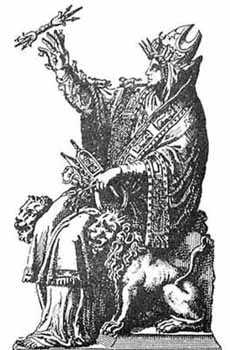
The same symbolic image of an Earth-mother with flanking lions can
be seen in the Earth-goddess unearthed at �atal H�y�k in Turkey
(left), and the European Cybele (right). The same iconic
symbol was also used by the Sumerian 'Gilgamesh' Hero-king.
(More about Gilgamesh)
'Like
the Neolithic settlements of the Near East, those in Greece offer a
variety of small animal figurines and statuettes of steatopygous
(fat-buttocked) women, testifying to a cult of the goddess of
fertility'. (6)
We are told by Larousse that: �Cretan iconography is associated
with the survival of the Neolithic mother goddess, symbol of
fertility with her bare breasts, the serpent, the bull�s horns,
which recur in the architecture, and the bird, which precedes the
dove of Aphrodite�. All of these icons
are repeated in the set of myths surrounding the oracle centers,
which are later imported from Egypt, and which relate to a deeper
set of myths.
We can now identify several features common to both the primitive
earth-goddess and the Sybil�s of ancient Greece; They were
invariably associated with the feminine, they were connected to both
serpents and doves (birds), and shared a similar set of traditions
with roots leading back to the primitive worship of an
�earth-mother� or �mother-earth�, in relation to agriculture and
harvest .
(Earth-Mother-Earth)
The close relationship between
Neolithic Greece and Anatolia is confirmed by Oliva who mentions
that the ceramic culture in Greece evolved from the beginning of the
sixth millennium B.C. He also says of it:
'It is highly probable that the
bearers of this new and more mature Neolithic culture were once
more immigrants from the east. Certain analogies in the ceramic
products suggest that they may have come from the region of
�atal H�y�k'.
(6)
(More
about �atal H�y�k)
|
 Greek Pyramids: Greek Pyramids:
It is a curious
fact that Greece is home to several small
pyramids (over 16 according to some sources). Even stranger then that the one in the picture right from Hellenicon
is currently dated at 2720 BC, placing it in the same time frame as the
early dynastic Egyptian pyramid building phase.
Recent dating by the Academy
of Athens of crystals
from internal surfaces of the limestone blocks using thermoluminescence
puts the construction times back two millennia. The Hellenikon pyramid was dated
to 2730 B.C.; the Ligourio pyramid, to 2260 B.C.
(5)
(Other European Pyramids) |
The Mycenaean's:
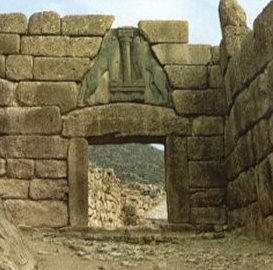 The Mycenaean�s flourished in the
absence of the Minoans (1,600 - 1,200 BC), and while there is little evidence that they were
concerned with geometry let alone things such as geodesy, the best known monument from
Mycenae suggests otherwise. The famous �lion-gate� (left), has been
suggested by Stecchini as having been a geodetic marker containing
Egyptian iconography, identifying it as a symbolic reference to geodesy. The Mycenaean�s flourished in the
absence of the Minoans (1,600 - 1,200 BC), and while there is little evidence that they were
concerned with geometry let alone things such as geodesy, the best known monument from
Mycenae suggests otherwise. The famous �lion-gate� (left), has been
suggested by Stecchini as having been a geodetic marker containing
Egyptian iconography, identifying it as a symbolic reference to geodesy.
The famous 'Treasury of Atreus' was built on the site of an
ancient oracle
centre. It is noticeable that its shape is comparable to a 'negative omphalos' in design.
The fact that both Greek and Roman travelers used to
measure 1 degree of latitude at 600 Greek Stadia or 75 Roman miles, a
measure which is only correct at the latitude of Mycenae, adds to the
suggestion that their �system of calculation goes back to the
Mycenaean ancestors of the Greeks�.
(27)
Mycenaean Lintels.
The Mycenean builders left behind some spectacular
examples of 'cyclopean' masonry. Of particular interest are the large
lintels covering the doorways to 'Tholos' or 'Tombs', the largest of
which is in the treasury of Atreaus, and estimated to
weigh around 120 tons.

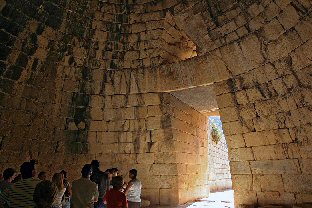
The lion-Tomb, Mcyenae (Left), Treasury
of Atreus (Right).
Note: These lintels were carved with curved faces,
similar to the Stonehenge Lintels
from Stonhenge III.
(More about
Mycenae)
|
Geodesy in Ancient
Greece.
Both Eratosthenes and Plato are known to have been actively
involved in the investigation of earthly measurements (Geo-metrica),
and it has long been concluded that such knowledge originated in
Greece, but it is now established fact that sciences including
astronomy and geometry were understood long before the Greek civilisation existed.
The idea that ancient Greek (pre-Hellenic) temples and
sacred locations were situated according to geometric principles
was also explored extensively by Th. Manias (Via Antonis T.
Vasilakis), who wrote that:
'The cultural invasion of the Cretans, in the various areas of the
northern (especially) hemisphere, commenced before the 4th
millennium B.C., creating several afterwards great civilizations
like the Egyptian and the great civilizations of south America.
Each of the different enormous cities built around the globe by
our ancestors, the Minoans (before the existence of any form of
civilization in Egypt), was a geodetic landmark of a colossal
system of annotation for each geographical longitude, with the
most ancient being the centre of the omphalic field of Knossos�
...(until).. �The grand disaster which took place in the second
half of the 16th century BC'.
Extract from the book of Th. Manias " Ta Agnosta Megaloyrgimata
Ton Arhaion Hellinon"
Also of
interest is the revelation by Manias that the Dodona, Delphi
and Trophonion oracle centres formed an isosceles triangle which
was part of a larger decagon, whose geometric elements extended to
other ancient sites such as Illion (Troy), Sparta and more
importantly, Knossos. He also showed how
Dodona (and other Greek sites such as Knossos and
Delos),
was located equidistant to other ancient sites and oracle centre's.
  Knossos (Left),
Dodona and
Delos
(Right). From Manias (2)
(Egyptian Geodesy)
(British
Geodesy)
|
The Phaistos disc.
The Phaistos Disc is a disk of fired clay from the
Minoan palace of Phaistos, possibly dating to the middle or late Minoan
Bronze Age (2nd Millennium BC). It is about 15 cm (5.9 in) in diameter
and covered on both sides with a spiral of stamped symbols. Its purpose
and meaning, and even its original geographical place of manufacture,
remain disputed, making it one of the most famous mysteries of
archaeology. This unique object is now on display at the archaeological
museum of Heraklion in Crete, Greece.
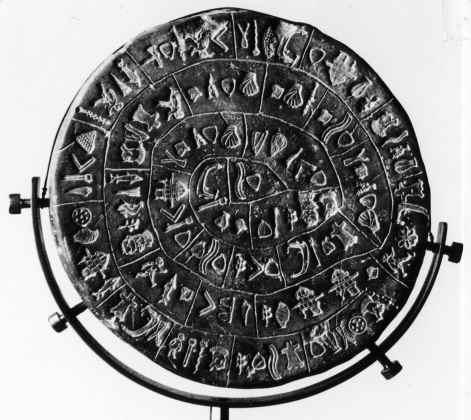
The disc was discovered in 1908 by the Italian
archaeologist Luigi Pernier in the Minoan palace-site of Phaistos, on
the south coast of Crete, and features 241 tokens, comprising 45 unique
signs, which were apparently made by pressing pre-formed hieroglyphic
"seals" into a disc of soft clay, in a clockwise sequence spiralling
towards the disc's centre.
(More about the Phaistos Disc)
|
List and Description of Greek Locations: |
|
Delos. |
|
The 'Floating Isle'. Birthplace of Apollo. |
|
Delphi. |
|
The 'Navel of the Earth'. |
|
Dodona. |
|
The first oracle centre in Greece. |
|
Knossos. |
|
Minoan Capital on Crete. |
|
Mycenae. |
|
Includes the Treasury
of Atreus / Lion Gate |
|










 The Mycenaean�s flourished in the
absence of the Minoans (1,600 - 1,200 BC), and while there is little evidence that they were
concerned with geometry let alone things such as geodesy, the best known monument from
Mycenae suggests otherwise. The famous �lion-gate� (left), has been
suggested by Stecchini as having been a geodetic marker containing
Egyptian iconography, identifying it as a symbolic reference to geodesy.
The Mycenaean�s flourished in the
absence of the Minoans (1,600 - 1,200 BC), and while there is little evidence that they were
concerned with geometry let alone things such as geodesy, the best known monument from
Mycenae suggests otherwise. The famous �lion-gate� (left), has been
suggested by Stecchini as having been a geodetic marker containing
Egyptian iconography, identifying it as a symbolic reference to geodesy.




